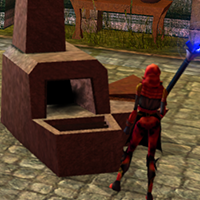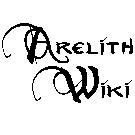Dweomercraft
 A forging workstation | |
| Crafting on Arelith: | |
|---|---|
| Alchemy | |
| Art Crafting | |
| Carpentry | |
| Herbalism | |
| Smithing | |
| Tailoring | |
| Dweomercraft - Runes | |
| Armor | |
| Weapons - Melee / Ranged / Siege | |
| Resources - Poison | |
Dweomercraft, formerly called Enchantment, is a way to customize equipment past what the crafting allows a player to do. Various properties can be added to many different types of items, from skill bonuses to weigh reduction.
Adding properties
- Approach an Enchantment Basin (or any corresponding crafting station, distributed around the module or created through Crafting) and place the item you would like to enchant inside, then close it.
- Cycle through the menu until you find the desired effect you would like to place on the item.
- Depending on the property, you may be prompted to be more specific with your decision (Generally Type -> Quality)
- When you have narrowed down your choice far enough, you will have the option to 'place' the property on the item. At this point the basin will show you the percent chance of success and the cost in gold.
- In case of failure, the item will be destroyed and the gold will be taken anyway.
- The lowest chance to add a new property is 5%.
- If the character is trying to enchant an item with 5% chance, failure will result in an XP penalty (1/10 of the gold cost).
Dweomercraft Tiers
The mechanics for basin improvements have been decoupled from Enchantment Spell Focus feats which they previously required. This art has been themed 'Dweomercraft' and can now be mastered in multiple ways.
There are three Dweomercraft Tiers, each unlocking benefits when improving items through a basin or a work station.
- [Tier I] - Unlocks +1 Skill Bonuses, +33% Chance of success from Runic, slight reduction to effective cost of the new item.
- [Tier II] - Unlocks +2 Skill Bonuses, +66% Chance of success from Runic, moderate reduction to effective cost.
- [Tier III] - +100% Chance of success from Runic, significant reduction to effective cost.
Dweomercraft Tiers are gated by character level. A character can only achieve Tier II at level 12 or higher, and Tier III at level 21 or higher.
Dweomercraft Tiers are granted by:
- Every 12 Levels in a Primary Caster Class. This includes Sorcerers, Druids, Clerics, and Wizards (not Spellswords).
- - Pale Master and Harper levels are added to the primary caster class level count, unless the character has more hybrid caster class levels.
- 21 Levels in a Hybrid Caster Class. This includes Bards (including Warlocks), Rangers, Paladins, and Spellswords. Another dweomercraft tier is added for the 28th level of a Hybrid Caster class.
- - Pale Master or Harper levels are added to the hybrid caster class level count, if the character has more hybrid caster class levels than primary caster class levels.
- Each invested Crafting Feat. This includes Scribe Scroll, Brew Potion, and Craft Wand.
- - Scribe Scroll counts as an invested Crafting Feat even if received automatically from Wizard levels.
- Each invested Skill Focus Feat in either Craft Armor or Craft Weapon. This includes Skill Focus and Epic Skill Focus in Craft Armor or Craft Weapon.
Examples:
- A Sorcerer at level 24 has 24 primary caster levels, so qualifies for Dweomercrafting Tier II. Picking up one Crafting Feat (say, Brew Potion or Skill Focus: Craft Weapon) would grant that character Tier III.
- A Wizard at level 24 has 24 primary caster levels, and also got Scribe Scroll automatically at level 1, so qualifies for Dweomercrafting Tier III.
- A Fighter (or other mundane character) with three Skill Focus feats (including one Epic Skill Focus) in Craft Weapon and Craft Armor qualifies for Dweomercrafting Tier III.
- A Cleric 10/Druid 14 has 24 total primary caster levels, so qualifies for Dweomercrafting Tier II.
- A Ranger 20/Bard 8 has 28 total hybrid caster levels, so qualifies for Dweomercrafting Tier II.
- A Druid 10/Bard 20 has 10 primary caster levels and 20 hybrid caster levels, so does not qualify for any Dweomercrafting Tiers.
Runic Items
Runic Items (rare loot with blue name) works differently to normal items Magical Items. They have a special property that can be exploited by enchanters that know and can read the specific languages the runes are written in. The next single enchantment that is added to that item will have an added success chance relative to the Dweomercraft Tier of the caster (See Above), and the runic property will not be able to be used again, even if the enchanter didn't have the matching requirements and enchanted the item as normal.
The Runes may be, and organized by their rarity:
- Basic (No requirement)
- Elven (Elven, Xanalress)
- Dwarven (Dwarven)
- Arcane (Draconic)
- Planar/Outsider (Celestial, Abyssal, Infernal)
Limitations
- The Enchantment Basin will only work with one item in at a time. Stacks of items (scrolls, potions, misc) are considered one item. Player will get a message notifying them if there is more than one.
- Not all items can be enchanted with all properties. Properties that are able to be enchanted onto an item will show up in blue, while the ones that aren't able will show up in red.
- It is possible to change the 'ownership' of an item by adding the new owners name in brackets when renaming the item in question.
- - For example, "Generic Super Sword [John Doe]"
- Item properties of the same 'type' may not stack. For example, it is possible to put +1 strength and +1 dexterity on an item without issue. It is not possible to put a Level 1 spell slot (wizard) and a Level 2 spell slot (wizard) on the same item, however.
- Appraise and Heal cannot be added as items properties through enchantment.
Tips
- It is a common practice to enchant a found basic item (such as a small statuette) with weight reduction to allow customization of that item by renaming it and changing its description.
- Crafting Feats: Having feats in Crafting (Scribe Scroll, Brew Potion, and Craft Wand) or skills focuses (Craft Armour/Weapon) grants the Dweomercrafter a boost to their ability to enchant.
- Those with Pale master and Harper levels should keep track of the Primary Caster classes and Hybrid Caster classes to maximise their effectiveness.
- Deities with the appropriate aspect grant a boon to the success chance of enchantments. This translates to a 50% chance of a failed enchantment succeeding anyway.
- Every enchantment will have at least a 5% chance of both failure and success.
- It is best to leave the more expensive enchantments for the end. If the value of the item was greater from the start, all the following enchantments onto that item would have a lower chance of success.
- There are various combinations and possibilities that a master enchanter could come up with for what a final item looks like, without falling down to 5% in their last attribute. An all-time favorite is +1 Ability, +1 Ability, +2 Skill, +2 Skill, +2 Skill, +2 Skill.
Specific properties
- Ability bonus (max bonus of +1)
- Strength
- Dexterity
- Constitution
- Intelligence
- Wisdom
- Charisma
- Important Note: An item with +1 Strength, enchanted with another +1 strength, will not grant +2 strength (this is stated above, but often forgotten).
- AC Bonus (max bonus of +1)
- Important Note: Type of bonus applied is dependent on item.
- Boots grant a Dodge bonus.
- Amulets grant a Natural Armor Bonus
- Armor/Robes grant an Armor bonus.
- Shields grant a Shield Bonus
- All other items grant a deflection bonus (helmet, rings, cloak, etc.)
- Important Note: Type of bonus applied is dependent on item.
- Enhancement Bonus (max bonus of +1)
- Important Note: This only applies for weapons
- Base Item Weight Reduction
- 20% (of total normal weight)
- 10% (of total normal weight)
- Note: It is not a 10% or 20% reduction in weight, rather the weight of the item becomes 10% or 20% of the norm.
- Bonus Spell Slot of Level
- All Classes
- Level 0 Slot
- Level 1 Slot
- Level 2 Slot
- Level 3 Slot
- Note: You can add non-caster spell slots, these do nothing.
- All Classes
- Damage Bonus (bonuses of +1 and +1d4 can be added of each element; elemental damages of different types stack).
- Acid
- Cold
- Divine
- Electric
- Fire
- Negative Energy
- Positive Energy
- Sonic
- Immunity: Damage Type (the immunity granted is 5%)
- Acid
- Cold
- Divine
- Electric
- Fire
- Negative Energy
- Positive Energy
- Sonic
- Damage Resistance (the resistance granted is 5/-)
- Acid
- Cold
- Divine
- Electric
- Fire
- Negative Energy
- Positive Energy
- Sonic
- Darkvision
- Enhanced Container: Reduced Weight
- Note: There are no containers currently in the module, so this is unusable. The closest to this are the Bags, but not even these may be enchanted.
- Spell Resistance
- 10
- Saving Throw Bonus (max bonus +1)
- Universal
- Acid
- Cold
- Death
- Disease
- Divine
- Electric
- Fear
- Fire
- Mind Affecting
- Negative Energy
- Poison
- Positive Energy
- Sonic
- Skills (see the above Dweomercrafting section for details on requirements)
- All of them except Appraise and Heal.
Customization
You can alter the item's description and name without cost or chance for failure. Normally, only the creator (or the last person who added a property to) the item can customize the item, but adding the name of a character in brackets at the end of the item's name would allow that character to customize it freely.
Adding the [all] tag to an item name will allow anyone to alter the item's name and description, however this tag will be invisible once added. Note that this is case sensitive.
- IE; "Amazing Gobbo Eye-poker [Boogo]".
- IE2; "Wit's End [Jericho Newman]".
- IE3; "Destiny [all]".
- The item must have a name. Just putting the character's name in brackets will not work.
